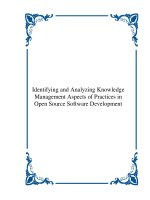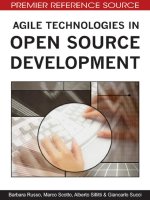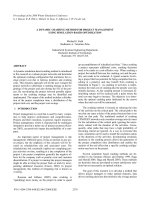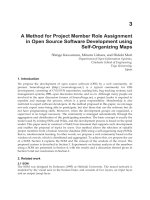intech-a method for project member role assignment in open source software development using self organizing maps
Bạn đang xem bản rút gọn của tài liệu. Xem và tải ngay bản đầy đủ của tài liệu tại đây (924.25 KB, 14 trang )
3
A Method for Project Member Role Assignment
in Open Source Software Development using
Self-Organizing Maps
Shingo Kawamura, Minoru Uehara, and Hideki Mori
Department of Open Information Systems,
Graduate School of Engineering,
Toyo University,
Japan
1. Introduction
We propose the development of open source software (OSS) by a web community. At
present, SourceForge.net ( is a typical community for OSS
development, consisting of CVS/SVN repositories, mailing lists, bug tracking systems, task
management systems, BBS, open discussion forums, and so on. Although many people are
involved in the open discussion forums of SourceForge.net, a project leader is required to
expedite and manage the process, which is a great responsibility. Membership is also
restricted to expert software developers. In the method proposed in this paper, we envisage
not only expert users being able to participate, but also those that use the software but do
not have programming skills. Moreover, when the development groups are organized, a
supervisor is no longer necessary. The community is managed automatically through the
aggregation and distribution of the participating members. The basic concept is exactly the
model used by existing SNSs and Wikis, and the development process is based on the spiral
model. This paper aims to construct a Web2.0 environment that supports such development
and enables the proposal of topics by users. Our method allows the selection of suitable
project members from a human resource database (DB) using a self-organizing map (SOM),
that is, reinforcement learning. In other words, we propose a web community based on the
wisdom of crowds, which is distributed and aggregated. To achieve this, we propose the use
of a SOM. Section 2 explains the SOM and the concept of the wisdom of the crowd. The
proposed system is described in Section 3. Experiments on feature analysis of the members
using a SOM are presented in Section 4, with the results and a discussion thereof given in
Section 5 and our conclusions in Section 6.
2. Related work
2.1 SOM
The SOM was designed by Kohonen (1995) at Helsinki University. The neural network is
modeled by the visual area in the human brain, and consists of two layers, an input layer
and an output (map) layer.
3
Self Organizing Maps - Applications and Novel Algorithm Design
56
2
1
1
n
jij
j
dx
Z
¦
(1)
x: input vector,
Z
: reference vector
Fig. 1. Example of a SOM
In a SOM, the most common similarity measure is the Euclidean distance, which is defined
as the distance of the input vector from the weight vector of a neural node. The nodes are
arranged in a two dimensional layout as shown in Figure 1(a), where x is the input vector
and
Z
the reference vector.
The weights of each node are initialized randomly in the initial state of learning. Then, the
node, whose weight vector is the closest to the input vector, is selected as the winner node
56
Self Organizing Maps - Applications and Novel Algorithm Design
A
M
usi
an
ne
i
w
h
re
g
E
a
an
cl
u
co
m
Si
n
b
u
pa
2.
2
It
cr
o
2).
ac
q
m
a
b
y
ha
k
n
th
e
al
t
Fi
g
M
ethod for Project
M
ng Self-Organizing
d the wei
g
hts
o
ig
hborhood func
h
ere
t
D
is the
g
ion.
a
ch wei
g
ht of a n
al
y
zed b
y
a SO
M
u
ster anal
y
sis. I
n
m
munit
y
. We a
n
n
ce the required
s
u
t also personal
i
rticipatin
g
and a
g
2
Wisdom of cr
o
is said that the
s
o
wds", that is, di
v
Recentl
y
, much
q
uirin
g
product
i
a
n
y
unspecified
m
y
man
y
voluntee
r
s been perfor
m
n
owled
g
e (wikis)
e
"wisdom of cr
o
t
hou
g
h, on the ot
h
g
. 2. Wisdom of c
M
ember Role Assi
g
Maps
o
f the winner
n
tion.
if
i
else (
ci
h
t
coefficient of lea
r
ode represents a
M
are shown in
n
this paper, w
e
n
al
y
ze the charac
t
s
kill set differs a
t
i
t
y
and aptitud
e
gg
re
g
ation is inc
o
o
wds
s
ervice known a
v
ersit
y
of opinio
n
attention has be
e
i
ve capacit
y
at
a
m
embers. Previo
u
r
s. In addition,
n
m
ed spontaneou
s
and experiences
o
wds". An adva
n
h
er hand nois
y
i
n
rowds
g
nment in Open So
n
ode and its nei
c
N
, then
0
(
ci
h
D
)0
t
()
(
cc
Nt N
r
nin
g
, T is the le
a
feature of the ob
j
Fi
g
ure 1(b). SO
M
e
use a SOM t
o
t
eristics of the a
v
t
each sta
g
e in a
p
e
in our anal
y
s
i
o
rporated in the
m
s the Web2.0 h
a
n
, independence
,
e
n focused on c
r
a
n appropriate l
e
u
sl
y
, developme
n
n
ot onl
y
OSS de
v
s
l
y
b
y
network
(blo
g
s) in recen
t
n
ta
g
e of this is
n
formation tends
urce Software Dev
e
g
hbors are upd
a
(
1/)tT
(
0)(1 / )tT ,
a
rnin
g
time, and
j
ect. As an exam
p
M
s are also usi
n
o
ensure divers
i
v
ailable human
r
p
ro
j
ect, we envis
a
i
s, as there ma
y
m
ethod.
a
s the characteri
s
,
decentralizatio
n
r
owd sourcin
g
,
w
e
vel in subcontr
a
n
t of OSS was d
o
v
elopment, but a
s of individual
t
y
ears. These ha
v
that diverse opi
n
to be exa
gg
erate
e
lopment
a
ted b
y
the fol
l
N
c
is the nei
g
hb
o
p
le, animal featu
r
ng
in data mini
n
i
t
y
of users in
a
r
esources usin
g
a
ag
e usin
g
not onl
y
y
not be an
y
e
s
tics of the "wis
d
n
, and a
gg
re
g
atio
w
hich is a techni
q
a
ctin
g
develop
m
o
ne in a similar
m
lso knowled
g
e s
s with the ne
c
v
e the characteri
s
n
ions can be re
f
d.
57
l
owing
(2)
(3)
o
rhood
r
e data
ng
and
a
web
a
SOM.
y
skill,
e
xperts
d
om of
n (Fi
g
.
q
ue for
m
ent to
m
anner
harin
g
c
essar
y
s
tics of
f
lected,
57
A Method for Project Member Role Assignment in
Open Source Software Development using Self-Organizing Maps
Self Organizing Maps - Applications and Novel Algorithm Design
58
3. OSS project
3.1 About C-DOS
OSS development often uses the agile development model that embodies short-term
iteration. We propose a web community for OSS development using a SOM implementing
the agile model for analyzing developers and their automatic assignment.
C-DOS (Community to Develop OSS using the Spiral model) is the name of the web
community dedicated to the development of OSS. C-DOS actually consists of two
communities; one to propose OSS projects and the other to promote these projects. Both
communities are implemented using OpenPNE (), which is an open
source SNS environment.
3.2 User participation
Anyone can register and participate in the C-DOS community. When users register, they
themselves must evaluate their IT development skills using SWEBOK (SoftWare
Engineering Body Of Knowledge) ( and provide personal
preferences to the community.
3.3 Proposal of a new OSS project
Once user registration has been completed, the user has the right to join the community, and
is registered in the human resources DB. If users have suggestions for new software
development or improvements to existing software, they can provide the requirements of
the project. Alternatively, they may put in a request to be included in the development team.
All requests are sent to the human resources DB. When the number of applicants exceeds
the pre-defined minimum, the suggestion is approved by the community and the project
starts. It should be noted that a "group leader" has not traditionally been an integral part of
this type of network of members ("suggests" included). Figures 3 and 4 illustrate the process
flows from registering a new user to starting a new project.
Fig. 3. Process flow for
user registration
58
Self Organizing Maps - Applications and Novel Algorithm Design
A Method for Project Member Role Assignment in Open Source Software Development
using Self-Organizing Maps
59
Fig. 4.
Process flow for project proposal
3.4 Model for development process
We propose a new development model based on the spiral model (Boehm, 1988). OSS often
uses the agile development model, which is flexible enough to be able to change OSS
definitions and requirements. But, it is limited to use by expert programmers only. Thus, we
have designed a development model for C-DOS that corresponds to the development
process. An outline of this model is shown in Figure 5.
Each project is broken down into 4 stages or layers covering the entire process, that is,
requirements, designing, building, and testing. After a project has been approved, the
project members are assigned to a particular layer by the SOM. Members assigned to each
layer can read the working data of the other layers, but cannot alter this data.
When members finish a series of tasks in the current layer, the next group of members begin
working on the corresponding next layer.
3.5 Development of an OSS project
Included in the community developing an OSS project are a Wiki and BBS. Members engage
in online discussions using the BBS and the results of each layer are written to the Wiki,
which can be updated by any of the project members. Updates are finalized when the
members in the layer approve the content. Moreover, updated results in the content of the
59
A Method for Project Member Role Assignment in
Open Source Software Development using Self-Organizing Maps
Self Organizing Maps - Applications and Novel Algorithm Design
60
Wiki are evaluated by all the members of other layers. If agreement is reached through
decisions of the majority of members, the task in the layer is considered completed.
Importantly, we have designed "bridge layers" between the main layers, where members in
a bridge layer have the right to participate in neighboring layers. The bridge layer has the
effect of design consistency. Members in the bridge layer are also selected by the SOM, with
the number of members being flexible.
Fig. 5. Model for development of C-DOS
4. Experiment
Processing to assign members to each layer is necessary in C-DOS. This can be achieved by
applying the cluster analysis described in this section, in which we conduct a SOM analysis
on the information provided on the registration forms and observe the results.
4.1 Skills evaluation
Member self evaluate their knowledge and skills for software development. The resulting
input data is based on a five-level rating scale using SWEBOK.
4.2 Analysis of candidate developers using SOM
In this section, we perform a SOM analysis, integrating our knowledge of candidates'
interests, hobbies, and their software development skills in relation to the community. Using
SWEBOK, it is possible to evaluate a member’s knowledge about software development.
60
Self Organizing Maps - Applications and Novel Algorithm Design
A Method for Project Member Role Assignment in Open Source Software Development
using Self-Organizing Maps
61
SWEBOK, established by a group led by the IEEE in 2001, is a system containing the
minimum knowledge that a professional should have acquired after working for four years
after graduation from university, The SOM analysis uses SOM_PAK, which is a tool
provided by Prof. Kohonen’s lab (Kate, 2002).
We show the detailed experimental conditions in Tables 1 and 2. In both evaluations, we
follow the taxonomy of Bloom (1956), and users self evaluate their skills in ten phases.
Table 1. Outline of the analysis using a SOM
Table 2. Input data format (knowledge and skill for software development)
Input Data 21 dimension
Map phase 12 x 8 hexagonal
Learning times 1000
I. Definition of requirement
i) Basis of software requirement
ii) Process of requirement
iii) Extract of require
iv) Analyses of requirement
v) Require to specification
vi) Confirm appropriateness of requirement
vii)
Consideration matters in practice
II. Designing skill
i) Basis of software design
ii) Main problems of software design
iii) Structure and architecture
iv) Analyses and evaluation of software designing quality
v) A notational system of software design
vi) Tactics and method
III. Programming skill
i) Basis of building software
ii) Management of building software
iii)
Consideration matters in practice
IV. Testing skill
i) Basis of software testing
ii) Test level
iii) Techniques of test
iv) Measure of test
v)
Test process
61
A Method for Project Member Role Assignment in
Open Source Software Development using Self-Organizing Maps
Self Organizing Maps - Applications and Novel Algorithm Design
62
Table 3. Experimental input data
62
Self Organizing Maps - Applications and Novel Algorithm Design
A Method for Project Member Role Assignment in Open Source Software Development
using Self-Organizing Maps
63
5. Results
We defined three reference models, namely, a specialist model, in which project members
have excellent scores for a specific skill phase, a generalist model, in which members have
good scores, above average in all phases, and an ordinary model, in which members
generally have immature skill scores. Scores in the 3 reference models are shown as (N-U),
W, and V, respectively.
SOM mapping is performed using the sampled score questionnaire from our OSS project
members including the reference models’ scores. Then, the distance is determined
between the sampled location and the reference model locations on the SOM map.
The data used for mapping is shown in Table 3. For instance, N and O specialize in a
phase I skill. A two-dimensional SOM is applied to 12x8 arrays. The SOM results are
illustrated in Figure 6, while the reference vector after the experiment is given in Table 4.
Mappings of the specialist reference model are located on the right of the map and form
their own clusters. Member G, because the skill value in phase II is the highest, is mapped
close to cluster (P, Q), which belongs to phase II of the specialist reference model. Member
H, on the other hand, despite the phase II skill value being as high as that of G, is mapped
far from P and Q, because, contrary to the previous case, the other skills are also high. In
the generalist case with a high skill value, the mapping is located on the upper left of the
map. Ordinary cases with no particular features are scattered around the map and do not
belong to any cluster.
6. Conclusion
We proposed a method using a SOM for the assignment of project members in the
development of OSS. In the method, member skills are expressed numerically for four
software development phases. Then a SOM analysis is carried out on the data, resulting in
developers being mapped and located on the map according to their skills. In the
experiment, we introduced reference models featuring varying skill levels for particular
phases of the development. Using a sample of selected members, we conducted a SOM
analysis on the data from the developer questionnaires, and then performed a comparison
of the distances between the reference models and the sample. For samples with a high
speciality in a particular skill, the mapping shows their location on the map close to the
corresponding reference models. According to the results, generalist members with
overall good skills in many development phases, are concentrated on the upper left of the
map. Members with average skills for each phase, on the other hand, are located
randomly on the map. In future research, using the data from previous successful OSS
projects, we intend to analyze the relationship between the proposed reference models
and actual skills data in order to refine the reference models.
7. Acknowledgment
We would like to thank Mr. N. Oguchi, S. Touji, and K. Matsumoto for their helpful advice
and encouragement during our research.
63
A Method for Project Member Role Assignment in
Open Source Software Development using Self-Organizing Maps
Self Organizing Maps - Applications and Novel Algorithm Design
64
Fig. 6. Experimental results
64
Self Organizing Maps - Applications and Novel Algorithm Design
A Method for Project Member Role Assignment in Open Source Software Development
using Self-Organizing Maps
65
65
A Method for Project Member Role Assignment in
Open Source Software Development using Self-Organizing Maps
Self Organizing Maps - Applications and Novel Algorithm Design
66
66
Self Organizing Maps - Applications and Novel Algorithm Design
A Method for Project Member Role Assignment in Open Source Software Development
using Self-Organizing Maps
67
.
Table 4. Reference vector
67
A Method for Project Member Role Assignment in
Open Source Software Development using Self-Organizing Maps
Self Organizing Maps - Applications and Novel Algorithm Design
68
8. References
S. Bloom. (Ed.) (1956). Taxonomy of Educational Objectives: The Classification of
Educational Goals; Handbook I, Cognitive Domain, New York
W. B. Boehm. (1988). Spiral Model of Software Development and Enhancement, IEEE
Computer 21(5): pp. 61-72
M. Furst. & R. A. DeMillo. (2006). Creating Symphonic-Thinking Computer Science
Graduates for an Increasingly Competitive Global Environment p.3.
(
A.S. Kate (Ed.) (2002). Neural Networks in Business: Techniques and Applications, IGI, Hershey
T. Kohonen. (1995). Self-Organizing Maps, Springer, New York
J. Surowiecki. (2005). The Wisdom of Crowds, Anchor, New York
68
Self Organizing Maps - Applications and Novel Algorithm Design









